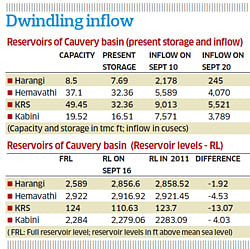The worrying decline in inflow into the major reservoirs in the Cauvery basin has forced the Karnataka government to reject the formula suggested by the Cauvery River Authority (CRA) for sharing the river water with Tamil Nadu.
To make matters worse, the south west monsoon is all set to end in the next 15 days, dampening any hopes of improvement in inflows in Harangi, Hemavathi, KRS and Kabini reservoirs in the Cauvery basin.
In an attempt to resolve the row over river water sharing between two states, Prime minister Manmohan Singh who heads the Authority, on Wednesday asked Karnataka to release 9,000 cusecs every day between September 20 and October 15 to its neighbour.
The State government has convened a meeting of all-party floor leaders at the chief minister’s home office “Krishna” in Bangalore on Friday to decide its future course of action. The Cauvery Protection Committee headed by former Congress MP G Made Gowda said in Mandya that the forum has decided to hold a week-long token agitation in Mysore, Chamarajanagar and Mandya districts.
As per statistics maintained by the Karnataka State Disaster Monitoring Centre and Water Resources Development Organisation, the present flow into the four main reservoirs in the Cauvery basin is a cause of worry. Inflow in the four reservoirs combined stood at 24,351 cusecs on September 10 but reduced to 13,625 cusecs on September 20 and is likely to dwindle by the day. The inflow at Harangi has been reduced to a trickle. Officials in the irrigation department say that against the normal flow of about 217 tmc ft, the flow into the reservoirs was as low as 102 tmc ft till the end of August.
The present live storage is barely sufficient to meet the minimum water requirements in the Cauvery basin of the state, the officials said. A top ranking government officer said in the present situation the State would not be able to release water to Tamil Nadu till October 15. Any release beyond September 20 will severely affect the basic drinking water requirements and the standing crops in the State.
The live storage in the Cauvery delta region of Tamil Nadu is 47 TMC, while 49 taluks in the Cauvery basin of Karnataka are reeling under drought. Unless the situation is assessed in mid October, the ground reality will not be clear, sources said.
On Wednesday in New Delhi, the official team from Karnataka staged a walkout from CRA meeting, stating that it cannot release any water owing to its difficult situation, while the Tamil Nadu representatives said their State would not accept the Prime Minister’s directive, insisting on its demand for release daily of two tmc ft of water. As many as 11,524 cusecs constitute one tmc ft of water.)
According to sources, at one point, Karnataka offered to release a maximum of 5,000 cusecs of water daily, but it was not acceptable to Tamil Nadu
As the PM gave his direction, the Karnataka team, led by chief minister Jagdish Shettar staged the walkout, saying the State cannot release “even one drop” of water considering its present situation. “We are not prepared to go against the interests of our farmers,” Shettar said, storming out of the meeting, held at 7, Race Course Road residence of the Singh.
After the meeting concluded, Tamil Nadu chief minister J Jayalalitha said her state would file an interim application before the Supreme Court seeking a direction to Karnataka to release water. Shettar said he told the meeting that the current storage level at the Mettur dam in Tamil Nadu was 47 tmc ft, while it was 76 in Karnataka reservoirs.
“For us, rainfall this season is over, but not for TN, as it will get the north-east monsoon. Karnataka needs stored water till beginning of monsoon next year. Besides, the drinking water needs of Bangalore City is met by by Cauvery. So, we cannot release water.”
Shettar said he also told the meeting that there was no distress formula on how to share water when monsoon fails, as it did this year.
